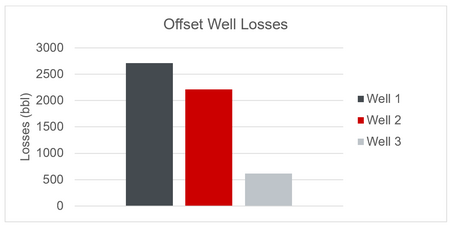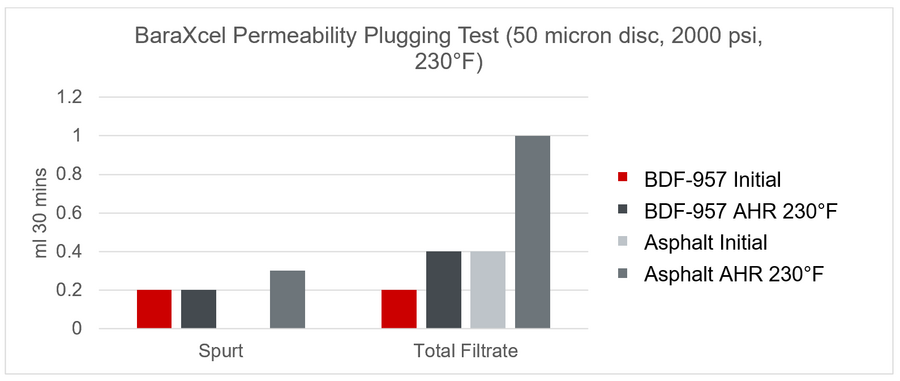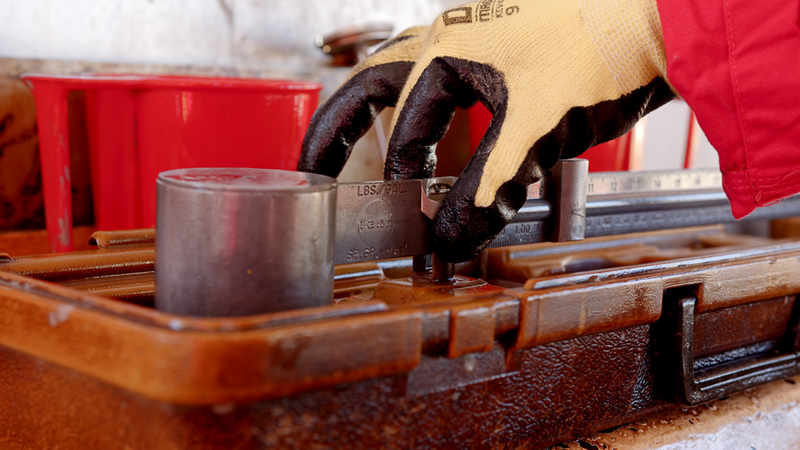 Search
Search
 Search
Search

BDF™-957 Wellbore sealant outperforms conventional asphalt additives to reduce downhole losses
Download PDFMarkham area
Differential sticking and hole collapse in intermediate section due to weak form
Halliburton Baroid recommended the following engineered solution:
Past development efforts in the Markham area of the Southern North Sea were plagued by wellbore instability and downhole losses in the coals and shale sequences—often leading to stuck drill strings, non-productive time (NPT) on running liners/casing, and complete loss of the sections in several offset wells. Efforts were made to optimize the fluids and lost circulation material (LCM) strategy for these sections with appropriate countermeasures for strengthening and sealing the coal seam fractures. For the operator’s proposed sidetrack well to reach its objectives in the reservoir, the fluid solution would need to seal depleted sandstone with an equivalent pressure limit of 4.5 lb/gal (fluid density of 9.3 lb/gal). Avoiding losses and leaving a competent wellbore for completion would drastically reduce development costs compared to failed attempts and additional sidetracks.
The previous wells were drilled by Halliburton Baroid using an ENVIROMUL® conventional NAF with STEELSEAL® 100 LCM and sulfonated asphalt additions for the coals (wells 1 and 2). The latest offset well (3) was drilled with BaraXcel™ NAF, including up to 100 ppb of BARACARB® ground marble, STEELSEAL, and sulfonated asphalt. Black powders can help to achieve tight fluid loss; however, the rheology profile, gels, and emulsion stability were adversely affected. The NAF for Well 3 was also treated with sacrificial grades of LCM, which were stripped out at the shakers after a single circulation. The maximum static and dynamic overbalance exerted onto the reservoir while drilling Well 3 was 2550 psi and 3300 psi, respectively, and yet this well experienced few losses compared to the previous two wells (shown below).

At least some of the losses on the last offset well (3) are thought to have been to sandstone. It is almost certain the BaraXcel NAF, laced with high levels of high- grade LCM, helped reduce losses to both the sandstones and coals. The higher the overbalance, the deeper the filtrate penetrates and the worse the instability. Control methods are limiting filtration and reducing the amount of free oil available within the fluid, by running the fluid with lower oil-water ratios. BaraXcel fulfills this technical need better than ENVIROMUL.
The ideal bridging agent matches the hardness and shape of the formation. This allows it to fit in with the exposed formation surfaces, which creates a rapid, well-fitting bridge. For coals, a more malleable material works best given the low Young's Modulus/UCS of the formation. This is why deformable products, such as asphalt, are suspected to work in combination with the other particulates. But the use of black powders (such as lignite and asphalt) in organophilic clay-free fluids interferes with the unique, fragile gel and rheology profile of these fluids. This can detract from the fluid’s ability to perform as expected. A product was needed that that would not adversely affect the BaraXcel fluid, yet still fulfil the malleable material requirement for a fast and effective fracture bridge.
BDF™-957 wellbore sealant was developed to aid the drilling of coals in place of the sulfonated asphalt, which was used on Well 3. This proprietary polymer was designed to provide rapid stabilization of microfractures and porous zones. Its small, deformable particles combine with existing solids and sized particulate materials in the fluid to effectively seal off openings of approximately 20-100 microns in size. A suite of lab testing was performed on sulfonated asphalt vs. BDF-957. This highlighted the negative effects asphalt had on BaraXcel. The rheology dropped off with the addition of the black powder, and the PV increased. With BDF-957, the rheology was much more stable and predictable. When compared to bridging on 50-micron aloxite discs, both products showed similar performance before hot roll; after hot roll, the BaraXcel with asphalt showed a significant increase in PPA filtrate (see below graph).

Testing on a 203-micron slot to simulate downhole fractures showed zero filtrate for the same fluid treated with BDF-957. The comparison fluid with asphalt had 1.3 ml/30 mins for the same test, and also showed signs of weakening emulsion stability (ES) after hot roll, with an ES reading of less than 200 volts.
The BaraXcel fluid system was treated with STEELSEAL / BARACARB / BAROFIBRE / BDF-957 bridging material before drilling the coals and unstable shale. Compared to previous wells, the BaraXcel with BDF-957 provided lower plastic viscosity (PV) and resulting ECDs. For the first time in the field, this solution allowed for efficient drilling of the section and completion:
The sidetrack well was delivered at a significantly lower cost than the previous well, and it is now the highest producing well in the field.

Custom drilling solutions for increased performance, more accurate planning and monitoring, and greater risk mitigation and safety.
